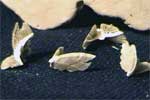Keyhole Sand Dollar, Mellita quinquiesperforata
Photos of the Keyhole Sand Dollar, Mellita quinquiesperforata, commonly mis-spelled Mellita quiquiesperforata, scientific classification and general information on habitat and range..

Keyhole Sand Dollar #01
Petalloids (used as gills), specialized tube feet, are arranged in a pattern favoring five flower petals. Five oval shaped holes, called lunules, pierce the test (skeleton) in keyhole urchins.
2816 x 2112 pixels

Keyhole Sand Dollar #02
Hundreds of tube feet, called podia on underside work in unison for locomotion.
2816 x 2112 pixels

Keyhole Sand Dollar #03
Doves inside Sand Dollar
Sea urchins, sand dollars and sea biscuits specifically have centrally located mouth on the underside. The mouth is a complicated arrangement of five teeth, called Aristotle's Lantern, used for scraping algae and other organic food from rocks (urchins) or under the sand (sand dollars and sea biscuits). The Aristotle's Lantern remains inside the sand dollar which is flat and has a small mouth opening. It primarily grinds its food. Openings in the others are larger allowing the toothy A-L to protrude and scrape/collect food. - Sally Thomas
2816 x 2112 pixels

Keyhole Sand Dollar #07
2816 x 2112 pixels

Keyhole Sand Dollar #04
2816 x 2112 pixels

Keyhole Sand Dollar #05
2816 x 2112 pixels
Keyhole sand dollar, Mellita quiquiesperforata, are dispersed along the east coast of the United States from Virginia to Brazil and also found along the coasts of Bermuda, Jamaica, and Puerto Rico.
Keyhole sand dollar is found in shallow waters below tide lines in sandy bottoms, burrowing for protection from waves and predators, and to obtain food. They feed on fine particles of organic matter they filter from the water.
Sand dollars are flat versions of sea urchins, reaching up to three inches in diameter and disk-like in shape. They differ greatly from their closely related cousin, the sea urchin.
The underside is usually flat or concave with the mouth directly in the center and the anus to one side. Its mouth is made up of five teeth arranged in a circle that form what is called, "Aristotle's lantern". Its skeleton is called a test and covered with an epidermis, spines (used in burrowing), tube feet (used for locomotion), and cilia. On its upper surface, petalloids (used as gills), specialized tube feet, are arranged in a pattern favoring five flower petals. Five oval shaped holes, called lunules, pierce the tests in keyhole urchins. There are two pairs of lunules, one pair toward the top and one large longer hole in between the second pair toward the bottom.
Coloration of the keyhole sand dollar varies, including tan, brown, and occasionally grayish or green hue.
Keyhole sand dollars pass through several life stages. After eggs have been fertilized they develop into swimming larvae. They drift in the sea water as plankton for four to six weeks, filtering tiny organisms. Juvenile keyhole urchins grow into adults, and live on the ocean floor.
Natural enemies of the keyhole sand dollar are sea stars, flounder, haddock, cod and other bottom feeding fishes.

Keyhole Sand Dollar #06
2816 x 2112 pixels












No comments:
Post a Comment